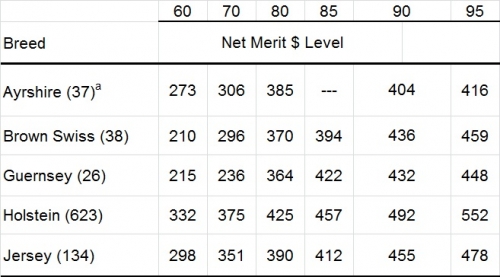Using selection indexes to make sire selection decisions
Selection indexes can simplify the process of choosing service sires for dairy herds.
Dairy producers have a multitude of information available to make sire selection decisions. Predicted transmitting abilities (PTAs) are computed for a number of traits in the broad categories of production (milk and milk components), health/fitness and type. The most effective way to consider a group of traits when choosing service sires is to use a selection index
A selection index incorporates several traits into a single genetic value. Traits are combined into the index based on relative economic weights of the traits. One commonly used selection index for dairy bulls is the USDA Net Merit index. In addition, the dairy breed associations each compute their own selection indexes.
Net Merit (NM$)
NM$ is computed by USDA Animal Improvement Programs Laboratory. It estimates lifetime profit based on incomes and expenses relevant for today’s dairy producers and is expressed as a dollar value.
Traits included in NM$ are: protein (lb), fat (lb), productive life, somatic cell score, udder composite, feet/legs composite, body size composite and daughter pregnancy rate. Calving ability($) also is included in NM$ calculations for Holsteins and Brown Swiss. The traits incorporated into calving ability for Holsteins are daughter stillbirth, service sire stillbirth, daughter calving ease and service sire calving ease. Only the two calving ease traits are available for inclusion in calving ability values of Brown Swiss.
The following table lists the NM$ values for various percentile ranking levels for each breed. Knowing where service sires rank relative to other active AI bulls is helpful in determining if the sires meet the herd’s genetic goals. To maximize genetic improvement using NM$ as your selection index, it is recommended that the service sires for your herd average at or above the 80th percentile.
NM$ levels of top percentiles for AI sires by breed. December 2011 USDA Sire Summary.

a. Number of bulls in the current active AI population for each breed are in parentheses.
Dairy Breed Association Indexes
The dairy breed associations have developed selection indexes that reflect the genetic goals determined by their respective boards of directors.
The U. S. Ayrshire Breeders’ Association uses a Production Type Index (PTI) as a ranking tool for Ayrshire bulls. This index accounts for protein, fat, type, daughter pregnancy rate, udder depth and somatic cell score.
TheProgressive Performance Ranking (PPR) is the selection index used by the Brown Swiss Association. Traits included in the PPR are protein, fat, somatic cell score, productive life, foot and leg composite, udder composite and daughter pregnancy rate.
The selection index developed by the American Guernsey Association is the Production Type Index (PTI). Traits combined in the PTI are: protein, fat, type, udder composite, foot and leg composite, productive life, daughter pregnancy rate, somatic cell score and strength.
Holstein Association USA calculates the Total Performance Index (TPI). It includes the traits of protein, fat, type, udder composite, feet and leg composite, daughter pregnancy rate, productive life, somatic cell score, daughter calving ease, daughter stillbirth and dairy form.
TheJersey Performance Index (JPI), which is used by the American Jersey Cattle Association, is comprised of the following traits: protein, fat, functional trait index, productive life, somatic cell score and daughter pregnancy rate. Functional trait index is based on the bull/cow PTAs for all type traits.
Using a selection index can be an effective way to consider several traits when choosing service sires. It is important to use an index which most closely meets your herd goals.



 Print
Print Email
Email



